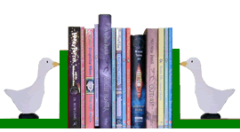All the information on this site is relevant to publishing children’s books. However, if that’s what you are planning to do, there are some important considerations you need to keep in mind.
Low ebook sales
So far, there has been a lower swing to ebooks in children’s publishing with the majority of young children still reading on paper. No one knows why this is the case. It could be because it’s more fun to cuddle up to Mum with a paper book than an ebook or it could be because books are more resilient to being trodden on than Kindles and tablets.
Whatever the reason, publishing purely in ebook format limits your sales more dramatically with a children’s book than with a book for adults. That makes a print edition an important part of your publishing plan.
You can’t wrap an ebook
Many children’s books aren’t bought by children at all. They are bought by parents, grandparents and other friends and relatives as presents and these people all want to buy a paper book they can wrap up. This is another reason why it’s important to have a paper edition of your children’s book.
Illustrations
Picture books for pre-school children are normally illustrated in full colour. Chapter books for beginners and newly-confident readers are usually illustrated too, often with black and white line drawings rather than full colour. Paying an illustrator to produce these pictures pushes up the cost of publishing considerably. If you want to produce children’s books on a very limited budget, aim for the older end of the market (8+) where there are usually no illustrations at all or maybe just one picture above each of the chapter headings.
Price
Printed children’s books are normally priced lower than books for adults which means profit margins are tighter. Traditional publishers can overcome this with the lower per-copy costs that comes with large print runs and with cost sharing deals with foreign language publishers. However, neither of these options are available to self-publishing authors and the higher per-copy costs of print on demand can make it difficult to price your book competitively.
All these issues make it harder to be successful self-publishing children’s books than it would be if you tackled a popular genre like romance. However, writing and publishing for children brings satisfactions beyond the purely financial ones. Your books can turn children into readers, stimulate their imaginations and introduce them to whole new worlds.
